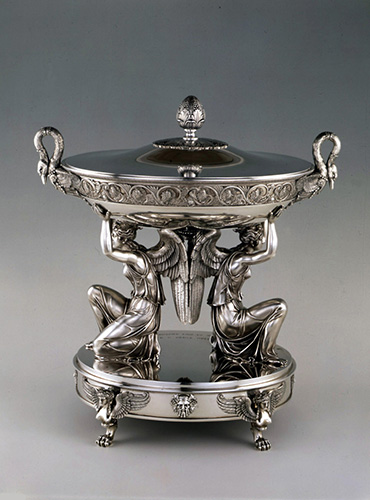Surveying the grandeur and opulence of the Empire style—championed by Napoleon Bonaparte during his rule as emperor of France—this major exhibition includes more than 250 objects drawn from the remarkable holdings of the Musée des Arts décoratifs-Paris and from prominent public and private collections in France.
The roots of the Empire style are traced to the late eighteenth century, when the classical vocabulary of Rome, as well as the archaeological discoveries of Pompeii and Herculaneum, captured the imaginations of a group of highly influential individuals. These include the painter Jacques-Louis David; the furniture maker Georges Jacob, who furnished David’s studio; and, most of all, the architects Charles Percier and Pierre-François Léonard Fontaine, who renovated Malmaison, the private country residence of Napoleon and Josephine. Napoleon quickly understood the power of ancient symbols to aggrandize his own ideas and promote and legitimize the image of the new French Republic. Soon after his coronation, he commissioned Percier and Fontaine to decorate his numerous state residences, and at the same time he actively exported this bold aesthetic throughout Europe.
Symbols of Power includes examples of the public and the private manifestations of the Empire style, both characterized by the use of neo-classical motifs such as columns and arches from Rome, for instance, and acanthus leaves and laurel wreaths from Athens. With furniture and decorative objects commissioned by the state (including works associated with Napoleon), the exhibition conveys the sumptuousness of the Empire style. It investigates the unusual combination of luxurious materials with austere forms that typify this style and signaled a clean break from the preceding stylistic delirium of the Rococo. The exhibition also examines the distillation of the hallmarks of the Empire style into a more intimate scale suitable for the growing bourgeois class. Installations reflect the totality of the Empire style, suggesting the complex juxtapositions of motifs and materials within interiors. Among the rich diversity of objects presented are furniture, textiles, clothing, jewelry, bronzes, silverware, porcelain, architectural studies, scenic wallpapers, and statues of Napoleon and Josephine.
ITINERARY



Curator
Odile Nouvel is Curator of Nineteenth-Century Art at the Musée des Arts décoratifs-Paris.
Credit
The national tour is made possible, in part, by the Joseph and Sylvia Slifka Foundation, Inc., and the Samuel H. Kress Foundation. The exhibition is also supported by an indemnity from the Federal Council on the Arts and the Humanities.

